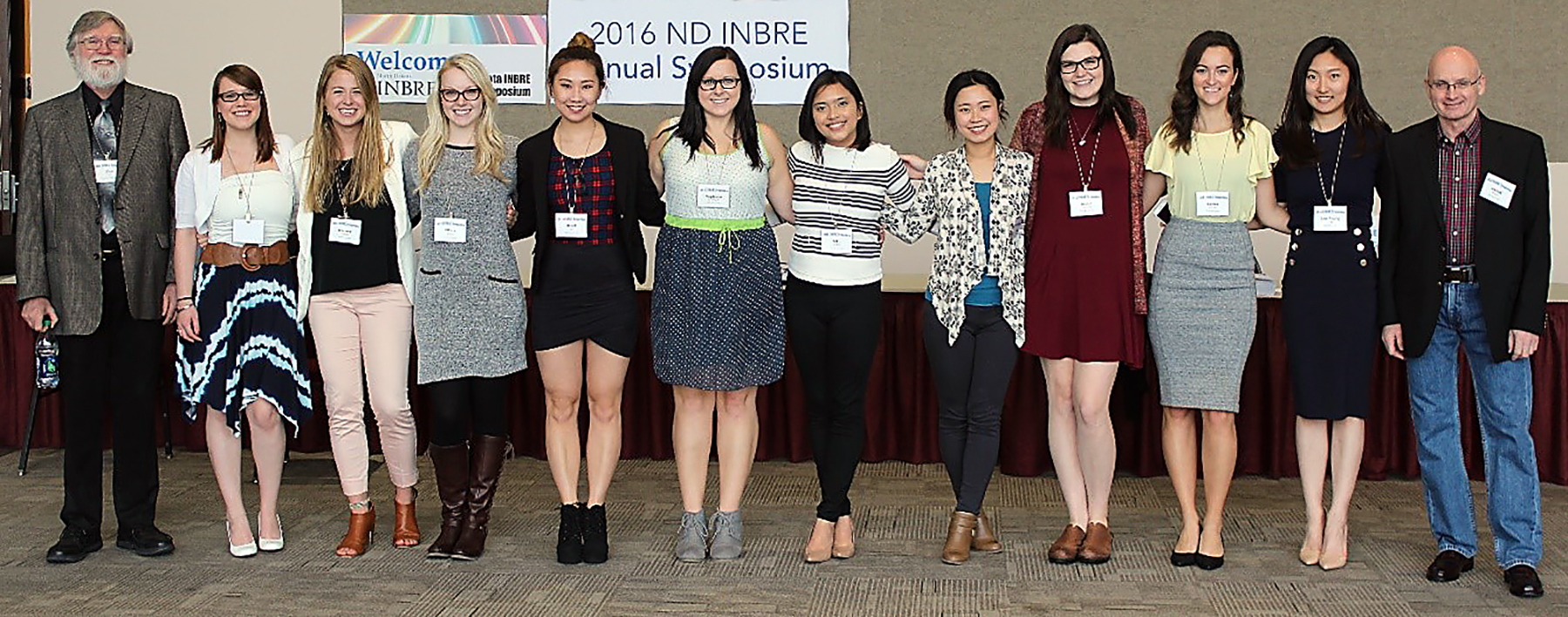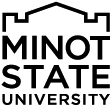
MINOT, N.D. – There are two main reasons Minot State University professor Mikhail Bobylev believes his research lab team that presented at the 2016 North Dakota INBRE (IDeA Networks of Biomedical Research Excellence) Annual Symposium in Moorhead, Minn., is significant.
First, the group has achieved an unprecedented rate of success in their careers with three individuals who have attended graduate school, three attending medical school, and one each in dentistry school, pharmacy school, and in K-12 as a teacher.
But, maybe more importantly, the group is all female.
The team of Tiffany (Dostert) Azzarello, Minot; Jin Hee Choi, Taean, South Korea; Kaylee Dockter, Bowbells; Breanne Hatfield, Manteca, Calif.; Hye Ji Lee, Los Angeles; Erika Mojica, La Union, Philippines; Shin Young Park, Seoul, South Korea; Tess Skinner, Camarillo, Calif.; Stephanie Sundhagen, Tioga; and Jordan Torgunrud, Estevan, Saskatchewan, constitutes a significant statistical shift in Bobylev’s research group, marking the first year the team was made up of all female students.
“The 2016 team was a great group, and a good story on how research can help you reach your career goals,” he said. “To have a research group of all female students was very encouraging. When I started here, most of my research students were boys, all the way until 2012. It changed very quickly.”
While statistics show women have made strides in overall percentage of degrees in the sciences, the 100 percent of the 2016 group is well above the average.
According to the National Science Foundation, in 1985-90, only nine percent of the bachelor’s degrees in science and engineering were awarded to women. From 1990-95, it rose sharply to 26 percent. As of a 2014 report from the Higher Education Research Institute, the percentage continued to rise to 37.5.
“The year I began medical school (2017) was the first year there were more women enrolled in U.S. medical schools than men,” said Dockter, a second-year student at UND’s School of Medicine. “I think this is an incredible shift that has been accomplished by supporting women. With that being said, I feel that Minot State faculty and staff have done an excellent job of supporting women — and men — to go into the sciences. Working in Dr. Bobylev’s lab was an incredible experience.”
 Dockter, Azzarello, and Mojica are all currently enrolled at the University of North Dakota’s School of Medicine. Hatfield is in her second year at the University of North Carolina Chapel Hill Graduate School. Torgunrud is in her first year of grad school at the University of Florida and Lee will began her first year at graduate school at North Dakota State in Fall 2019. Choi is in her second year of dental school at Loma Linda School of Dentistry in California. Park is in her first year of pharmacy school at the University of Minnesota. Sundhagen began teaching in Velva this fall and Skinner is a senior at Minot State who will graduate in May 2019.
Dockter, Azzarello, and Mojica are all currently enrolled at the University of North Dakota’s School of Medicine. Hatfield is in her second year at the University of North Carolina Chapel Hill Graduate School. Torgunrud is in her first year of grad school at the University of Florida and Lee will began her first year at graduate school at North Dakota State in Fall 2019. Choi is in her second year of dental school at Loma Linda School of Dentistry in California. Park is in her first year of pharmacy school at the University of Minnesota. Sundhagen began teaching in Velva this fall and Skinner is a senior at Minot State who will graduate in May 2019.
According to Bobylev, the shift from males to females in his research group happened naturally simply because female students were showing a better grasp of organic chemistry and a higher interest in research.
“It seems like now we have high focused, highly independent, highly motivated women who outcompete the men here at Minot State,” he said. “The research group becomes a community that supports them and it’s a big part of their social life.”
None of the students on the 2016 team felt there were obstacles placed in their way due to gender, and all praised both Minot State and its faculty in fostering an environment that embraced all students.
“Fortunately, most of my educational/professional experiences have occurred in environments where I have been given the same opportunities as my male counterparts,” said Mojica. “When I was working in Dr. Bobylev’s lab, all of my co-researchers were women. I think that MSU really does strive to foster equality by allowing advancement for all students regardless of their demographic — even if on the nationwide scale we still see a ‘glass ceiling’ for women and various minorities. I never felt that I was being held back from achieving my potential.”
“The greatest part of it all was feeling the power of women in science. Since science is such a male dominant field, seeing every female colleague succeed was such an excitement,” Lee added.
The support at Minot State and beyond is a common theme.
“I really liked how close knit most of the students were. We worked together on everything and generally got along,” said Torgunrud. “(Chemistry professors) Naomi Winburn was a huge influence for me, as well as Lucy Bobyleva. The faculty at Minot State are amazing. They really do care about you more than just a student ID in their gradebook.”
“My experiences with females in the sciences has been absolutely empowering,” said Azzarello. “From the military to graduate school to teaching, each one of them pursued something that made me admire their hard work. Some of the changes that we are seeing in educational institutions are the disregard for gender. Their standards to reach excellence are uniform across all genders. I’ve never felt like what I was doing was unobtainable.”
“I had some amazing mentors who encouraged me to think about other careers and who challenged me to consider graduate school. One in particular was Mrs. Bobyleva,” Hatfield said. “She is the one behind the scene, crafting our laboratory technique. I still hear her in my head today, ‘Rocket, Rocket, Incline, Last Droplet.’ She gave us the courage to be just as good as the men in our field, and even surpass them.”
Bobylev believes a significant portion of the success this group has achieved is rooted in intangibles obtained through conducting and presenting research.
“It starts with an interest in science and research,” he said. “All of the schools – med school, vet school, grad school, dental school — these individuals are applying to and getting into have highly competitive processes. The research sets them apart. They have been to multiple meetings, presented dozens of times.”
Park and Choi both agree their work — primarily their ability to focus on research as an undergraduate student — has set them apart.
“Without these four years of incredible research experience under Dr. Bobylev and Mrs. Bobyleva’s supervision, and three years of internship at Trinity Health Pharmacy, I wouldn’t be where I am today,” Park said. “Especially in pharmacy school, organic chemistry is a very important subject to have as a base knowledge to learn about different drugs along with their interaction. At University of Minnesota, we have a research emphasis path. After I learn about those different researches, I am planning to be involved in research.”
“These conferences definitely broadened my eyes to see what is happening out there in the real world in regards to the science field,” Choi added. “This gave me opportunities to present my knowledge to the public by giving an oral and poster presentation. Also, this allowed me to meet students from other schools and learn what their research was about.”
 While much of the focus on the team centers around postgraduate work, Sundhagen moved directly into the workforce and gives back in the form of a K-12 science teacher.
While much of the focus on the team centers around postgraduate work, Sundhagen moved directly into the workforce and gives back in the form of a K-12 science teacher.
“Studying chemistry at Minot State has been such a positive experience for me. I never would have pursued a degree in chemistry without the guidance and advice from Dr. Bobylev and Mrs. Bobyleva. They saw potential in me that I never saw in myself,” she said. “We got direct help from a doctor of chemistry in most cases, and I loved that. Not to mention the research experiences – I am doing organic chemistry research with the opportunity to travel around the country to national meetings of the American Chemical Society. I couldn’t have ever dreamed I would have that opportunity.”
Having an individual like Sundhagen move into a teaching profession was especially satisfying for Bobylev.
“Graduate school and some of the other schools are a stepping stone into academic research or into the corporate world, and sometimes into teaching, to become a professor at a college,” he said. “But we do have a significant population here at Minot State that from the very beginning, they want to teach. Almost from the very beginning, Stephanie wanted to be a science teacher. She was very impressed with her science teachers in Tioga and that set her on the path. Stephanie is very dedicated to that.”
While the 2016 team’s gender might have set them apart from the national average, it’s their dedication to research, in Bobylev’s eyes, that truly sets them apart.
On average, the members of the group spent three full years conducting research in Bobylev’s lab, which included both the fall, spring, and summer semesters, spending nearly as much time in his lab as they spent in all other classes combined.
That hard work paid off.
The group presented their research results at 12 professional meetings, on average, including two to three presentations at the national meeting of the American Chemical Society, the largest scientific society in the world. Three of the members, Dockter, Choi, and Torgunrud, were selected to present their research to members of congress at Posters on the Hill in 2015, 2016, and 2018.
“It takes a lot of determination to do research like this,” he said. “We feel the opportunity to do undergraduate research is what sets us apart, when they talk to students at larger schools, those students are amazed at how much research they get to do. It’s not just something they can do, it’s a requirement for us.
“This group excelled at that.”

About Minot State University
Minot State University is a public university dedicated to excellence in education, scholarship, and community engagement achieved through
rigorous academic experiences, active learning environments, commitment to public service, and a vibrant campus life.
Published: 10/29/18



